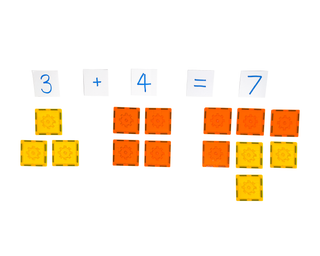|
Purpose |
To develop students’ concepts of counting and addition |
|
Developmental Area(s) |
Cognitive: Number Sense (Understanding quantity), Representation (Using symbols to represent numbers), Problem Solving
Motor: Fine Motor |
|
Lesson Objective(s) |
- Solve given addition problems using Magnetic Tiles
|
|
Materials |
- Magnetic Tiles
- Post Its
- Marker
- Flat surface (i.e floor, table, fridge, baking sheet etc)
|
|
Preparation |
Prior to the lesson, create two sets of Post It/sticky notes numbered from 0-20, and use two to draw an addition (+) and equal (=) sign. Decide on basic addition problems that are within your students’ current math skills. |
|
Procedure |
Introduce Activity
- Review counting from 1-20 with students, preferably using a visual aid such as a number wall or number rug.
- Introduce the idea of addition (i.e. “I have one super fast toy car, if I add another race car, let's count how many we have now! One car plus another car equals two cars!”
Activity
1. Stick the first Post-it equation on the flat surface (i.e. 1+2=?).
2. Explain to students how to count out the correct number of magnetic tiles and put them under each number (i.e. three magnetic tiles under the number 3).
3. After each child builds their equation, direct them to count all of the magnetic tiles under the equation to solve their addition problem.
4. Problem solved! Help students verbalize their equation (i.e. “Two plus three equals five!”) and place a Post It note with the correct answer at the end of the equation.
5. Repeat!
|
|
Differentiation |
General Challenges
- Print a visual representation of the finished product. Encourage the child to simply match while helping them identify the number
- Use equations with numbers 0-5 only
- Rather than an individual activity, complete this lesson as a group
- Refer back to a familiar visual number representation such as the class number wall to help conceptualize numbers.
|
|
Assessment |
When finished the activity, ask children to identify their equation and check that they counted out the correct number of magnetic tiles in their math problem. |

